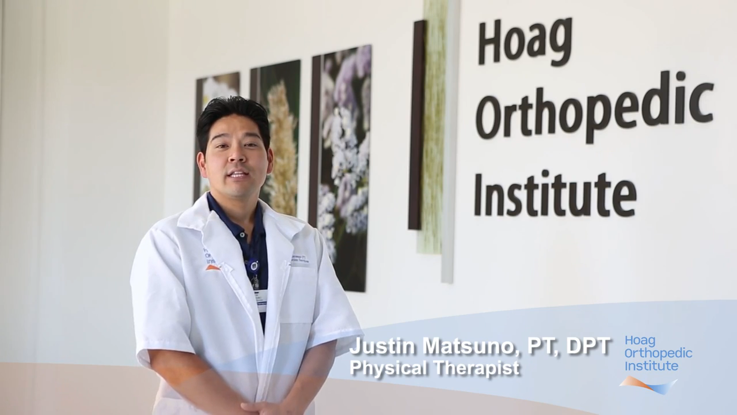Anterior Cervical Discectomy
(ACDF) & Fusion Surgery
Have you been told that Anterior Cervical Discectomy and Fusion (ACDF)
surgery might be in your future? Also known as anterior cervical decompression
and fusion, this procedure is often recommended when a damaged or herniated
disc in the cervical spine has not responded to more conservative treatments.
The ACDF surgical procedure is a
common spinal procedure with a high success rate. At Hoag Orthopedic Institute, our fellowship-trained,
board-certified spine surgeons specialize in ACDF surgery, helping patients
regain an active, pain-free life.
But what is anterior cervical discectomy and fusion, and what can you expect if you move forward with the procedure? Let’s explore how ACDF surgery can relieve your pain and help you get back to doing the things you love.
What Is Anterior Cervical Discectomy and Fusion Surgery?
A damaged or herniated disc in the cervical spine (the vertebrae in your neck) can compress the spinal cord or nearby nerves, causing burning, radiating pain, numbness, or tingling in the neck or arms. Anterior cervical discectomy and fusion surgery relieves this pressure by removing the damaged disc and replacing it with a bone graft or implant. The graft helps maintain proper spacing and allows the vertebrae above and below the removed disc to fuse over time, stabilizing that section of the spine.
Conditions Treated with ACDF Surgery
ACDF surgery is typically used to treat cervical spine conditions that cause nerve or spinal cord compression. Common conditions treated with the ACDF surgical procedure include:
- Bone spurs
- Cervical radiculopathy
- Degenerative disc disease
- Herniated discs
- Myelopathy, or spinal cord compression
- Spinal fractures
- Spinal stenosis
Who Can Benefit from the ACDF Procedure?
With proper care, a herniated disc often heals, alleviating the neck pain, numbness, or weakness it caused. When a damaged disc does not respond to more conservative treatment, such as physical therapy, medication, or steroid injections — the ACDF procedure may be used to relieve persistent symptoms and restore stability to the cervical spine.
ACDF surgery can help alleviate pain and restore mobility for individuals with ongoing symptoms related to a damaged or herniated disc, including:
- Numbness or tingling in the arms or fingers
- Radiating pain in the neck, shoulder, or arm
- Muscle weakness in the hands, arms, or shoulders
ACDF Surgical Procedure: What to Expect
During anterior cervical discectomy and fusion, the surgeon removes a damaged disc in the neck to relieve pressure on the spinal cord or nerves. The ACDF procedure is performed under general anesthesia and typically takes about two hours. A breathing tube will be inserted to help you breathe during the surgery. This may cause a sore throat or difficulty swallowing for a few days following ACDF surgery.
The surgeon makes a small incision in the front of the neck, usually along a natural skin crease, to help limit scarring. This anterior approach allows the surgeon to reach the cervical spine without cutting through the muscles at the back of the neck. The surgeon removes the herniated disc or any other material impinging on the spinal cord or nerves. The empty disc space is then filled with a bone graft or implant to support spinal alignment and encourage the neighboring vertebrae to fuse. The surgeon may use a small plate and screws to stabilize the area during the healing process.
ACDF surgery is often described as “minimally invasive” because it uses a small incision and avoids cutting through major back muscles, but it is still a major spinal procedure. It’s less invasive than many other spinal surgeries, but it is neither “minor” nor low-risk. While most patients will not need to spend the night in the hospital, they must arrange to have someone drive them home after ACDF surgery. Some patients may require an overnight hospital stay.
Anterior Cervical Discectomy Recovery and Rehabilitation
Most patients recover well from their anterior cervical discectomy procedure at home. Avoid strenuous activity for at least six weeks post-ACDF surgery. Your doctor will let you know when you can return to your normal activities. Walking and similar low-impact aerobic exercises are encouraged.
Avoid strenuous exercise, including contact sports, for at least three months. Follow your doctor’s advice when it comes to these activities. Depending on the physical demands of your job, plan to take four to six weeks off from work. This can also include jobs requiring long periods of sitting, which can cause neck pain during anterior cervical discectomy recovery.
Avoid heavy lifting, which includes tasks like carrying grocery bags or lifting children and pets. ACDF rehabilitation may involve wearing a neck brace and doing exercises recommended by your doctor to boost neck strength and range of motion.
Expect full recovery from ACDF surgery to take between six to 12 months for the complete solidification of the fused neck bone to occur.
Why Choose Hoag Orthopedic Institute for ACDF Surgery
At Hoag Orthopedic Institute, our experts are dedicated to spine and orthopedic treatments. HOI was named a 2024-2025 “Best Hospital” by U.S. News and World Report. When determining the best hospital to undergo ACDF surgery, HOI has a reputation and track record that is second to none.
Schedule a consultation with one of our top spine surgeons today by calling us at 949-705-6493.
We Get You Back to You®!
-
 Back to Driving Spine & Neck
Back to Driving Spine & Neck"Procedure: Complex Spinal Surgery Watching TV, taking long walks, getting up out of a ..."
Read More -
 Back to Enjoying Life After Spine Surgery Spine & Neck
Back to Enjoying Life After Spine Surgery Spine & Neck"Procedure: Spinal fusion Jonathan Dibiasi and his family love spending time at their ..."
Read More -
 Back to Running After Spine Surgery Spine & Neck, Sports Medicine
Back to Running After Spine Surgery Spine & Neck, Sports Medicine"“I can’t believe I’m walking, let alone running,” says car crash survivor, seven-time ..."
Read More -
 Back to Savoring Every Day Hand & Wrist, Spine & Neck
Back to Savoring Every Day Hand & Wrist, Spine & Neck"Procedures: Spinal Surgery: January 16, 2017; Right Wrist Fusion: January 12, 2018 ..."
Read More -
 Back to Painting Spine & Neck
Back to Painting Spine & Neck"Procedure : Multi-level Spinal Fusion At age 69, lifelong professional artist ..."
Read More -
 Back to Wearing Cowboy Boots Spine & Neck
Back to Wearing Cowboy Boots Spine & Neck"For two years, Sally Greer spent most of her time on her couch, and gained 130 pounds ..."
Read More -
 Back to Being Healthy Spine & Neck
Back to Being Healthy Spine & Neck"I would like to get a message to a couple of your staff members and their supervisor. ..."
Read More -
 Back to Dance After Spine Surgery Spine & Neck
Back to Dance After Spine Surgery Spine & Neck"For the past decade, Irvine aerospace engineer Shoja’s zest for life led him to grace ..."
Read More -
 Back to a Better Life Spine & Neck
Back to a Better Life Spine & Neck"I had spine surgery by Dr. Richard Lee on January 3rd. It appears to have been been ..."
Read More










